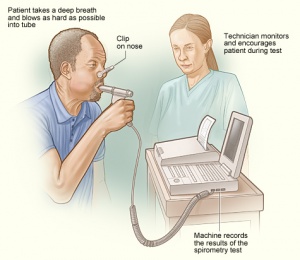Spirometry: Difference between revisions
No edit summary |
No edit summary |
||
| Line 25: | Line 25: | ||
* Post-MI.<ref name=":0" /><ref>Cooper BG An update on contraindications for lung function testing Thorax 2011;66:714-723.</ref> | * Post-MI.<ref name=":0" /><ref>Cooper BG An update on contraindications for lung function testing Thorax 2011;66:714-723.</ref> | ||
== | == Protocol == | ||
Spirometry is the most frequently used measure of lung function and is a measure of volume against time. It is a simple and quick procedure to perform: patients are asked to take a maximal inspiration and then to forcefully expel air for as long and as quickly as possibl | |||
== Measurement definitions == | |||
{| class="wikitable" | {| class="wikitable" | ||
|Forced expiratory volume in one second (FEV<sub>1</sub>) | |Forced expiratory volume in one second (FEV<sub>1</sub>) | ||
| | |The volume of air that is forcibly exhaled after full inspiration in the first second. | ||
|- | |- | ||
|Forced vital capacity (FVC) | |Forced vital capacity (FVC) | ||
| | |The volume of air that is forcibly exhaled after full inspiration. | ||
|- | |- | ||
|The ratio of the two volumes (FEV1/FVC) | |The ratio of the two volumes (FEV1/FVC) | ||
| | |This calculation allows the identification of obstructive or restrictive ventilatory defects. FEV1/FVC <70% where FEV1 is reduced more than FVC suggests an obstructive pathology. FEV1/FVC >70% where FVC is reduced more so than FEV1 is seen in restrictive pathology. | ||
|- | |||
|Vital capacity (VC) | |||
|The maximum amount of air that can be exhaled when blowing out as fast as possible | |||
|- | |||
|Peak expiratory flow (PEF), | |||
|The maximal flow that can be exhaled when blowing out at a steady rate | |||
* | |||
|} | |} | ||
== | == Resources == | ||
{| width="100%" cellspacing="1" cellpadding="1" | {| width="100%" cellspacing="1" cellpadding="1" | ||
Revision as of 20:20, 8 March 2018
Original Editor - George Prudden
Top Contributors - George Prudden, Uchechukwu Chukwuemeka, Kim Jackson, Rucha Gadgil, Vidya Acharya, Chelsea Mclene and Admin
Description
[edit | edit source]
Pulmonary function tests (also lung function test or spirometry) are useful investigations in the management of patients with respiratory disease or respiratory weakness secondary to neurological impairment. They aid diagnosis, help monitor response to treatment and can guide decisions regarding further treatment and intervention.[1]
Indication[edit | edit source]
- Investigation of patients with symptoms/signs/investigations that suggest pulmonary disease (e.g. cough, wheeze, breathlessness, crackles or abnormal chest x-ray)
- Monitoring patients with known pulmonary disease for progression and response to treatment (e.g. interstitial fibrosis, COPD, asthma or pulmonary vascular disease)
- Investigation of patients with disease that may have a respiratory complications (e.g. connective tissue disorders or neuromuscular diseases)
- Preoperative evaluation prior to (e.g. lung resection, abdominal surgery or cardiothoracic surgery)
- Evaluation patients a risk of lung diseases (e.g. exposure to pulmonary toxins such a radiation, medication, or environmental or occupational exposure)
- Surveillance following lung transplantation to assess for acute rejection, infection or obliterative bronchiolitis[1]
Contraindications[edit | edit source]
Protocol[edit | edit source]
Spirometry is the most frequently used measure of lung function and is a measure of volume against time. It is a simple and quick procedure to perform: patients are asked to take a maximal inspiration and then to forcefully expel air for as long and as quickly as possibl
Measurement definitions[edit | edit source]
| Forced expiratory volume in one second (FEV1) | The volume of air that is forcibly exhaled after full inspiration in the first second. |
| Forced vital capacity (FVC) | The volume of air that is forcibly exhaled after full inspiration. |
| The ratio of the two volumes (FEV1/FVC) | This calculation allows the identification of obstructive or restrictive ventilatory defects. FEV1/FVC <70% where FEV1 is reduced more than FVC suggests an obstructive pathology. FEV1/FVC >70% where FVC is reduced more so than FEV1 is seen in restrictive pathology. |
| Vital capacity (VC) | The maximum amount of air that can be exhaled when blowing out as fast as possible |
| Peak expiratory flow (PEF), | The maximal flow that can be exhaled when blowing out at a steady rate
|







